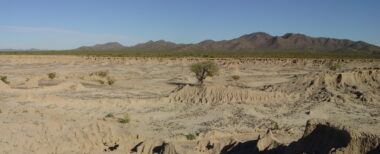John Carpenter – “Raising Time to the Level of Explication: 13,000 Years of Adaption in the Sonoran Desert at La Playa (SON F:10:3)”

Our research at the extraordinary La Playa Site (SON F:10:3) is now entering its 23rd year. This site is located at the Boquillas Valley about 10 kilometers north of Estación Trincheras and some 27 kilometers west of Santa Ana, Sonora. The La Playa site presents an archaeological landscape revealing evidence of more or less continuous human use since the Paleoindian period (ca. 13,000 years ago). Its most intensive use was during the Early Agricultural period (3,700–2,050 cal BP or 2100 BCE to 150 CE); after this period, the occupation of the Boquillas Valley greatly diminished, but the site was continuously occupied by the Trincheras tradition people, Piman groups, French goat herders, and even a hotel and restaurant was in operation there during the 1950s.
Countless thousands of hornos (roasting features), several hundred human inhumation and cremation burials, numerous dog burials, shell ornament production and lithic reduction activity areas, caches of manos and tabular “lap stone” slabs, and a schist quarry are the predominant features associated with the Early Agricultural period. To date, we have investigated a total of 620 archaeological features, including 310 mortuary features with 345 individuals (301 inhumations and 44 cremations), 30 canid inhumation burials and four canid cremation burials, one burned pit house and 118 roasting pit features. Maize kernels and cupules are present in 47% of the analyzed roasting features. This lecture presents a cultural-historical account of the longue durée of these human occupations and their varied adaptations represented in the archaeological record.
 All Posts
All Posts